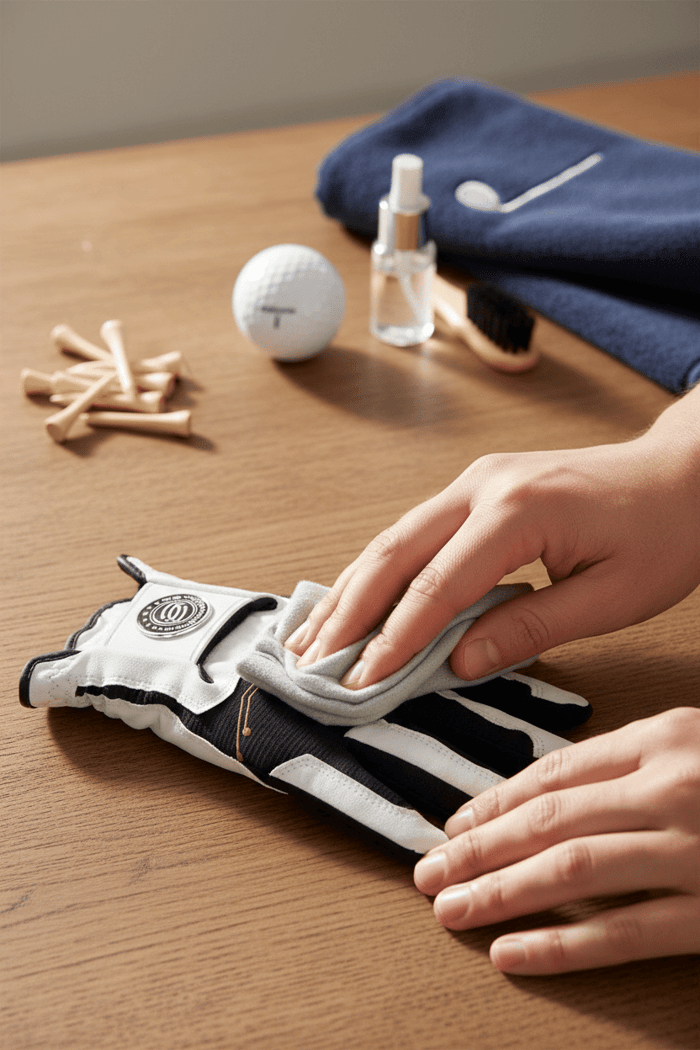Table of Contents
Ever feel like you’re running a small glove replacement business? The average golfer is spending over $100 a year replacing their gloves because they’ve turned hard, crusty, and stiff. You paid good money for that premium feel, and now it feels like a piece of dry cardboard. The truth is, your glove isn't failing you; your care routine is.
Stop throwing cash in the trash. I'm going to share the simple, pro-tour secrets I use to make my gloves feel new again, round after round. You'll keep your grip tacky, your confidence high, and your wallet a little heavier.
1. The Pro Golfer's Secret: Care Starts Before the 19th Hole
If you take just one tip from me, make it this: you absolutely must rotate your gloves. This single habit can easily triple your glove's life and is the best way to maintain that buttery-soft feel and critical tackiness.
Why Rotation is the Most Important Step for Longevity
Here’s the science of the stiff glove: The real damage isn't friction from your grip; it's the salt and oil residue left behind by your sweat.
When a glove gets soaked and then crumpled up in your bag, the saltwater dries into tiny, sharp crystals. These crystals pierce the delicate leather fibers, which is why it comes out brittle and crusty.
Rotation gives the glove 24 to 48 hours to fully dry out and allows the leather fibers to recover their natural structure. If you play often, you should have at least two quality gloves: one to wear and one to rest.
Taking Your Glove Off the Right Way
A lot of golfers ruin the fit of their glove by yanking it off.
Never pull on the fingers. That stretches the glove and strains the stitching in the palm. Instead, gently unclasp the Velcro tab, and then work the cuff off the back of your hand slowly. This preserves the snug fit that's essential for a great grip.
How to Air-Dry Any Golf Glove (The 3 Things to Avoid)
As soon as it’s off your hand, your glove needs to air out. Forget speed drying.
Don't use heat: Keep your glove away from the clothes dryer, a hairdryer, or your car's dashboard. Extreme heat causes the leather to shrink and become permanently brittle.
Don't leave it wadded up: Lay the glove completely flat on a towel indoors.
Don't hang it by the Velcro: That thin tab isn't meant to support a damp glove's weight and will stretch the wrist material, ruining the fit.
2. Stop the Stiffness: Proper Storage and Preservation
The battle for a longer-lasting glove is won or lost when you're off the course. Where and how you store your glove is the second major reason you're buying replacements too soon.
The Problem with the Wadded Glove
Think about how a damp leather shoe would dry if you threw it into a ball—it wouldn't dry well, and it would be misshapen. Your golf glove is the same.
Crumpling a damp glove guarantees it dries stiff, brittle, and out of shape right along the crease lines. These creases become the first spots where holes and tears start to form.
Glove Keepers Versus the Box
To make sure your glove dries in its perfect, original shape, you have a couple of great options:
Glove Keepers or Stretchers: These simple plastic tools slide inside your glove, holding the fingers and palm extended. They guarantee airflow and ensure the glove dries perfectly flat.
Original Packaging: If you don't have a keeper, smooth the glove out flat and slide it back into the paper envelope or pouch it came in. This protects it from getting crushed by your balls and tees.
Temperature and Humidity Matter
Avoid storing your gloves in places that get too hot or too damp:
Hot Car Trunk/Dashboard: The intense, dry heat is a quick way to destroy the leather, sucking out the natural oils and causing cracking.
Damp Garage or Locker: High humidity can lead to mildew and bacteria growth, which is exactly why they start to smell so bad.
Store them flat, dry, and cool. An inside pocket of your golf bag or a bedroom drawer is always better than the trunk.
3. The Definitive Guide to Cleaning Your Golf Glove
You sweat into your glove every single round. It picks up dirt, grass, and oils. Cleaning isn't just about appearance; it's about removing the performance-killing residue that destroys the tackiness.
Taking Care of Premium Cabretta Leather
Cabretta leather is the gold standard for feel, but it's the most sensitive. Never use a washing machine on leather.
Here's the gentle hand-wash method I rely on:
Prep: Put the glove on your hand and secure the Velcro tab.
Clean: Wet your hand with cold water. Apply a tiny dab of mild, pH-neutral soap (like baby shampoo or a special leather cleaner). Gently lather, focusing on the palm.
Rinse: Rinse completely with cold water until all soap is gone. Any leftover soap will make your grip slick.
Reshape: Remove the glove, blot it with a clean, soft towel, and immediately reshape it flat. Then, let it air-dry naturally.
Condition (Optional): Once it’s fully dry, a small amount of leather conditioner can bring back its suppleness and stop it from cracking.
Cleaning Synthetic and Hybrid Gloves
Synthetic materials are tougher and more water-resistant.
Machine Washing: Many modern hybrid gloves can handle the washing machine. If you go this route, always use a mesh laundry bag to protect the Velcro, choose the delicate cycle with cold water, and use a mild detergent.
Air Dry Only: Even if you machine wash them, do not machine dry them. Air drying flat is the only way to go.
The Fix for a Glove That's Already Crusty
If you find a glove that’s already stiff and you're ready to toss it, you might be able to save it:
Soak: Submerge the stiff glove in a bucket of cool water with a little mild soap for about 15 minutes.
Flex the Leather: While it's submerged, gently flex the glove to loosen those dried salt deposits and rehydrate the fibers.
Rinse and Reshape: Rinse thoroughly and follow the air-drying and reshaping steps above. It won't feel brand new, but it will be a major improvement.
4. Why Your Glove is Tearing (It’s Not Always the Glove)
Sometimes, the wear pattern is actually a valuable diagnostic tool for your golf swing. Fixing the cause can help your gloves last even longer.
Diagnosing Holes in the Palm or Thumb
Specific tears can tell you a lot about your grip:
Wear on the Heel of the Palm: This often means you're holding the club too much in your palm, causing the material to bunch and rub. You need to adjust to a more finger-oriented grip.
Wear on the Thumb or Index Finger: This is the most common sign that you're gripping the club too tightly. That excessive squeeze creates massive friction in those specific spots.
Your Fit is Everything
A golf glove should fit "like a second skin." If you see wrinkles or excess material in the palm, that material is going to rub against your club grip and tear quickly. A perfect fit makes sure the glove moves as one with your hand.
If you struggle with sweaty hands or play in the rain, you might want to look at a glove that’s built specifically to handle moisture. Copper Tech Golf Gloves use a specialized blend of leather and synthetic materials engineered to maintain their tack and fit, even when damp, far longer than thin leather gloves.
Save Your Best Glove for the Course
Hitting a large bucket of range balls puts the equivalent wear of several rounds onto a single glove. To get the most out of your premium glove, use an older, worn glove or a cheaper synthetic glove just for those long practice sessions. You’ll save your best glove for the course when feel matters most.
Final Thoughts
You don't have to keep buying new gloves because the old ones turn into leather chips. By just getting into the habit of rotation, smart drying, and flat storage, you're making a huge improvement. You're not just saving money; you're guaranteeing a more consistent grip and better feel every time you swing.
Take control of your equipment by taking proper care of it. Invest in a glove that's built to last, and see the difference a perfect grip makes.


.jpg)


